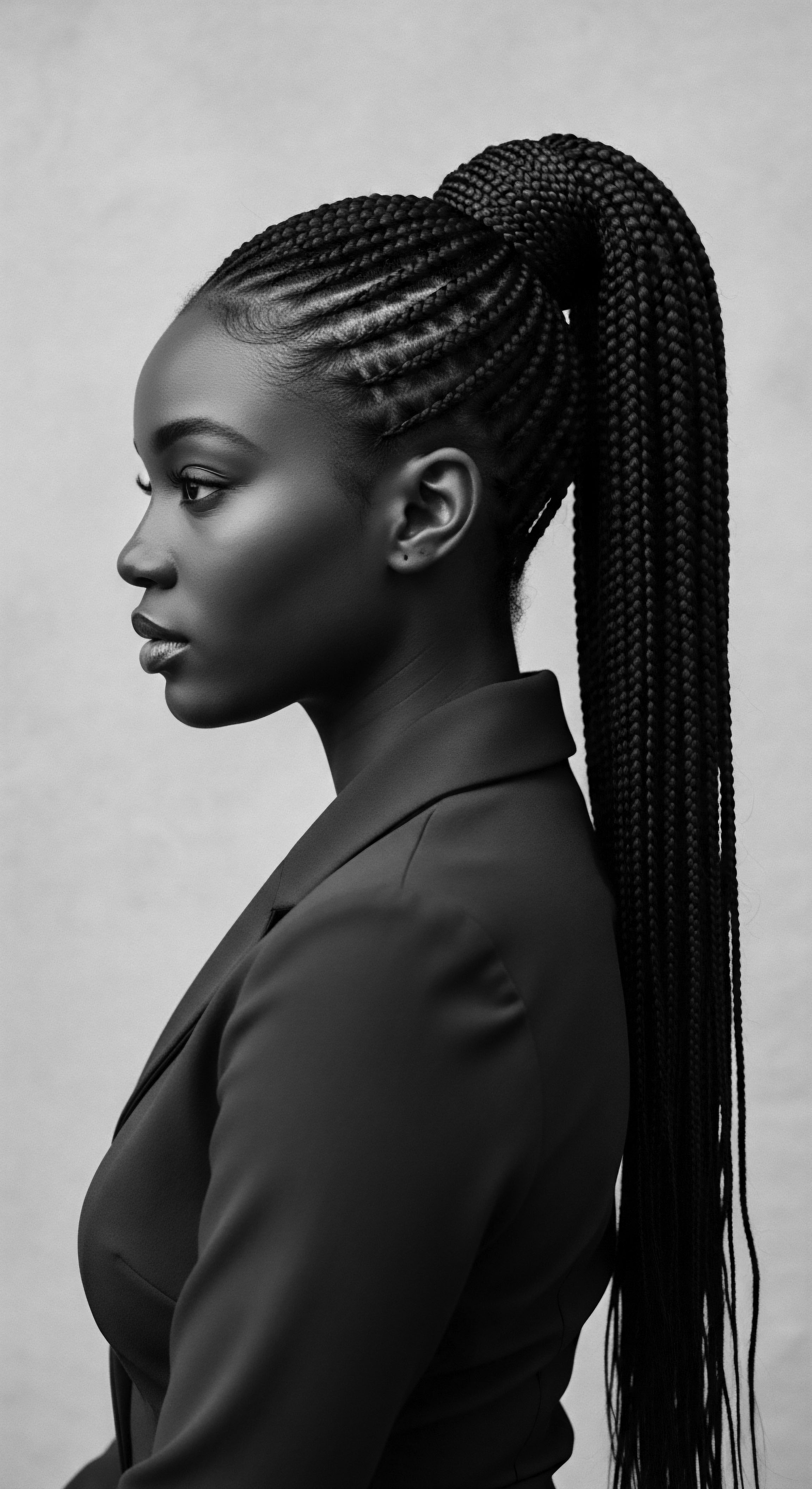
Fundamentals
The ancient wisdom surrounding Argania Spinosa Uses begins with a humble tree, resilient in the arid landscapes of southwestern Morocco. This particular species, Argania spinosa, yields a fruit housing a kernel, which, through painstaking traditional methods, becomes the highly prized argan oil. The foundational understanding of its application for textured hair rests upon its capacity to provide profound moisture and protection.
For generations, this golden liquid has served as a cornerstone of hair wellness within communities, particularly those with deep ancestral ties to the argan forests. It offered solace for strands exposed to harsh environmental conditions, providing a shield against dryness and external elements.
The core Explanation of Argania Spinosa uses for hair centers on its remarkable composition. This oil holds rich concentrations of Fatty Acids, specifically oleic and linoleic acids, alongside generous amounts of Vitamin E and other vital antioxidants. These elements work in concert, offering conditioning effects to the hair shaft and scalp.
Its light yet nourishing quality means it can penetrate strands without leaving behind a heavy feel, a consideration of paramount importance for the varied structures of textured hair. The traditional practices recognized this innate characteristic, integrating it into daily rituals to maintain suppleness and a natural sheen.
Argania Spinosa uses, steeped in ancestral wisdom, offer textured hair a profound source of moisture and protection, a legacy passed through generations.
Across the expanse of time, from the earliest documented accounts, communities recognized a natural synergy between Argan oil and the vitality of hair. The methods of extracting this oil from the argan kernels, often performed by women, reflect a profound connection to the earth and its gifts. This deep-seated knowledge, passed down through matriarchal lines, forms the very fabric of its historical importance. It is a story whispered in the rustle of leaves, carried on the desert winds, and visible in the radiant crowns tended with this precious botanical.

Ancient Origins and Initial Recognition
The history of Argania Spinosa, particularly its oil, traces back centuries, perhaps even millennia. Early mentions suggest its application for light sources around 4,000 years ago. However, its acknowledged properties as a cosmetic treatment find documentation as far back as 1219 by the physician Ibn Al Baythar, who meticulously chronicled its many healthful attributes. This early recognition hints at a long-standing appreciation for its capabilities, not merely as a utilitarian substance but as a valued ingredient for self-care.
- Berber Traditions ❉ For centuries, Berber Women, also known as Amazigh women, in southwestern Morocco harnessed the benefits of argan oil. They discovered its effectiveness in shielding hair and skin from the demanding dry climate.
- Hair and Skin Hydration ❉ The historical application of argan oil focused on its ability to hydrate and nourish, serving as a primary tool to preserve skin and hair from the sun’s intensity and the desert’s aridity.
- Daily Rituals ❉ Women routinely applied pure argan oil to their hair to promote length, shine, and overall well-being, keeping it resilient and vibrant without scalp issues.
These ancient practices underscore a fundamental truth about plant-based wellness ❉ communities observed, experimented, and codified knowledge that resonated with the needs of their bodies and the specific challenges of their environments. The simple act of applying argan oil to hair was a testament to empirical observation, a practice refined through lived experience across countless sunrises and sunsets. The understanding of its capabilities was woven into daily life.

Intermediate
The intermediate conceptualization of Argania Spinosa Uses delves beyond surface-level hydration, exploring its deeper historical significance and the community systems that sustained its presence within beauty regimens. The meaning of this oil extends into the realm of cultural practice, a communal thread binding generations through shared rituals of care. It represents a living legacy, particularly for those whose hair textures benefit profoundly from its unique molecular structure and protective attributes. This phase of understanding highlights how this ingredient became more than a mere product; it served as a symbol of resilience and collective well-being.
The traditional methods of preparing argan oil are central to its ancestral spirit. This labor-intensive process, traditionally undertaken by Berber Women, transformed the tree’s fruit into a golden elixir. The ripe fruits, often gathered after goats consume the outer pulp, are dried under the sun. Subsequently, the hard nuts are cracked open manually, frequently between two stones, to reveal the precious kernels within.
These kernels, after air-drying, are then carefully ground into a paste, sometimes with a small amount of water. This paste then undergoes a hand-kneading process to separate the oil.
Beyond simple application, Argania Spinosa uses embody a communal heritage, reflecting centuries of shared wisdom in hair care.
This meticulous, time-honored preparation ensures the oil retains its inherent qualities, a testament to the dedication of those who have preserved these techniques. It is a contrast to modern, often mechanized, extraction, yet both paths yield an oil with notable benefits. The manual work involved, requiring up to ten hours to extract a single liter of oil, speaks to its value and the deep reverence held for this natural gift. Such methods underscore a connection to the material world and a patience often absent in contemporary production cycles.

Cultural Threads of Care
Within various African traditions, the act of oiling hair transcends simple grooming; it represents a sacred ritual, a moment of connection, and a protective gesture. For West African communities, oils and butters were consistently applied to hair to maintain moisture in warm, dry climates, frequently paired with protective styles to help retain length and health. Argan oil, while originating from North Africa, stands as a testament to the continent’s rich array of botanicals utilized for hair wellness. This shared philosophy of deep nourishment for textured hair types speaks to a collective ancestral understanding of environmental adaptation and self-preservation.
| Aspect Kernel Preparation |
| Traditional Production (Ancestral Practice) Manual cracking of nuts, often between stones; kernels air-dried. |
| Modern Production (Contemporary Methods) Mechanical shelling and drying processes. |
| Aspect Extraction Method |
| Traditional Production (Ancestral Practice) Hand-grinding kernels into a paste, followed by water addition and manual kneading to express oil. |
| Modern Production (Contemporary Methods) Cold-pressing or expeller-pressing, often in industrial units or co-operatives with hydraulic presses. |
| Aspect Time & Labor |
| Traditional Production (Ancestral Practice) Extremely time-consuming and labor-intensive; one liter could take ten hours. |
| Modern Production (Contemporary Methods) More efficient, significantly reducing labor and time per liter. |
| Aspect Primary Producers |
| Traditional Production (Ancestral Practice) Exclusively Berber women, often in communal settings. |
| Modern Production (Contemporary Methods) Women's cooperatives and larger industrial operations. |
| Aspect Cultural Significance |
| Traditional Production (Ancestral Practice) Deeply rooted in heritage, community bonding, ancestral knowledge transfer. |
| Modern Production (Contemporary Methods) Economic empowerment, standardization for global markets. |
| Aspect The evolution in production methods signifies an adaptation to global demand, yet the foundational knowledge passed down through generations remains invaluable. |
The application of Argania Spinosa oil for hair care often served to smooth and protect the hair cuticle, reducing frizz and enhancing natural luster. The lipid composition, particularly the fatty acids, works to seal the hair’s outer layer, retaining moisture. This protective barrier proves especially beneficial for textured hair, which can be prone to dryness due to its unique structural properties and curl patterns. Such care extended to both adults and children, a practice underscoring the intergenerational commitment to hair wellness.

Socio-Economic Resonance
Beyond its direct application to hair, the Economic Meaning of Argania Spinosa for Berber women has shaped communities for centuries. The production of argan oil has historically been, and largely remains, an activity carried out by women. This work provides an income that significantly impacts their livelihoods and social standing. In rural areas, this labor often represented a critical means for women to achieve financial autonomy and contribute to their families’ economic well-being.
The establishment of Women’s Cooperatives for argan oil production marked a significant shift, amplifying the social and economic impact. These cooperatives not only maintain the traditional methods of oil extraction but also provide education and improved living standards for their members. These collective efforts demonstrate how the ancestral practices surrounding Argania Spinosa have adapted to contemporary realities, providing a model of sustainable development rooted in cultural preservation. This communal approach strengthens bonds and supports social inclusion for Amazigh women in marginalized regions.
- Community Empowerment ❉ Cooperatives focused on Argan oil production have given women a structured place of work, often including educational programs. This initiative helps women in rural areas acquire literacy skills.
- Financial Independence ❉ Membership in organizations like the Union of Women’s Cooperatives for Argan Oil (UCFA) has significantly improved the financial standing of many women, allowing them to support household expenses and invest in their children’s schooling. (Haddi, as cited by Yassine, 2024).
- Cultural Identity ❉ These cooperatives contribute to the traditional and cultural identity of argan oil, helping to maintain the high quality of the product while preserving ancestral techniques.
The story of Argania Spinosa is therefore not simply one of botanical application; it is a profound narrative of human agency, communal endeavor, and the enduring power of heritage to sustain livelihoods and cultural forms. The oil becomes a tangible link to a rich past, a living testament to wisdom passed down through touch and shared endeavor. Its continuous use reflects not only its efficacy but also its deep embedding within cultural values.

Academic
The precise Delineation of Argania Spinosa Uses for textured hair extends beyond its surface-level conditioning properties, revealing a complex interplay of biochemical compounds and profound cultural systems. From an academic perspective, understanding this botanical’s utility involves dissecting its lipid profile, examining its bioactivity on the hair follicle and shaft, and, critically, placing these scientific understandings within the profound ancestral and diasporic contexts where it has been revered. The oil extracted from Argania spinosa kernels represents a unique biological resource, deeply intertwined with human identity, particularly for individuals with coil, curl, and wave patterns, whose hair structure often demands specific forms of care and moisture retention.
The composition of cosmetic argan oil is notably rich in unsaturated fatty acids, with a substantial presence of oleic and linoleic acids. These fatty acids contribute significantly to its emollient properties, supporting the integrity of the hair structure and reducing fragility. Beyond lipids, argan oil contains a spectrum of bioactive molecules, including tocopherols (Vitamin E), squalene, and polyphenols, which collectively contribute to its purported antioxidative and anti-inflammatory attributes. These compounds work to protect the scalp from oxidative stress, often caused by environmental factors, and to soothe irritation, conditions that can impact hair vitality, especially for sensitive scalps common within textured hair communities.
Argania Spinosa’s molecular architecture aligns with ancestral care, showcasing a historical congruence between botanical wisdom and hair physiology.
One might view Argania Spinosa uses as an archetypal instance of indigenous ethnobotanical knowledge being affirmed by contemporary scientific inquiry. For centuries, Berber women, through empirical observation, utilized this oil to confer resilience upon their hair and skin in harsh desert climates. Modern investigations now explain these long-observed effects by identifying specific biochemical pathways.
For instance, the linoleic acid within argan oil helps to reinforce the scalp’s natural barrier, preventing moisture escape and safeguarding against external aggressors. Such biochemical mechanisms contribute to healthier hair growth by promoting a conducive environment at the follicular level.

Biochemical Affinity with Textured Strands
Textured hair, with its unique helical structure and often elevated cuticle layers, possesses distinct moisture retention challenges compared to straighter hair types. The natural oils produced by the scalp struggle to traverse the intricate curves of coiled strands, leaving the lengths and ends more susceptible to dryness and breakage. This inherent characteristic makes external lipid application, such as argan oil, particularly advantageous.
The oil’s ability to penetrate the hair axis and damaged follicles, as some research suggests, helps in giving hair a fuller appearance and a more lustrous finish. This is consistent with traditional practices where consistent application of oils was central to maintaining hair health and preventing desiccation.
While the scientific community still seeks comprehensive clinical trials specifically detailing argan oil’s direct impact on hair growth in humans, its robust conditioning and protective qualities are widely recognized. The oil helps to smooth the hair cuticle, thereby reducing friction between strands, which often leads to frizz and mechanical damage in textured hair. Moreover, the antioxidative properties of Vitamin E within argan oil offer a layer of defense against environmental insults, aiding in the preservation of hair’s strength and elasticity. This capacity to maintain hair integrity indirectly supports its perceived ability to foster longer, healthier hair over time by minimizing loss from breakage.

Challenges and Nuances in Scientific Validation
A systematic review from 2022, examining the current state of research on argan oil for hair growth, indicated no significant evidence supporting its direct role in stimulating new hair growth. This academic assessment suggests that while its conditioning benefits are apparent, the anecdotal claims regarding growth promotion require further rigorous investigation. This distinction highlights the disjunction that can exist between generations of practical application and the specific parameters of modern scientific validation.
Despite this, the profound historical reliance on argan oil within certain cultures for comprehensive hair care remains undeniable, speaking to an efficacy experienced outside the laboratory. It demonstrates a form of knowledge acquired through consistent, communal use over extended periods.

Argania Spinosa as a Cultural Keystone
Beyond its biochemical makeup, Argania Spinosa’s Significance unfolds as a cultural keystone species, particularly within Moroccan society, and by extension, for the global tapestry of textured hair heritage. The tree and its products are central to the social and economic fabric of the Berber communities, embodying a deep connection to the land and ancestral ways of living. Its harvesting and processing are not merely agricultural tasks; they are communal acts, frequently performed by women’s cooperatives, which foster social cohesion and economic empowerment.
One compelling example of Argania Spinosa’s enduring connection to ancestral practices and its tangible impact on Black and mixed-race hair experiences, even across diasporic lines, is evident in the Socio-Economic Transformation of Berber Women through Cooperative Models. For generations, the labor of extracting argan oil was arduous and often yielded meager returns for individual women. Yet, with the formalization of women-led cooperatives in the late 20th century, a more equitable and empowering structure emerged. As of 2023, the total number of cooperatives in Morocco reached 60,000, with 7,730 being entirely female-run.
These organizations have demonstrably improved the financial well-being and social standing of Amazigh women, enabling many to gain financial comfort and experience social advancement. The cooperative framework has allowed traditional methods of argan oil production to be preserved while also creating a global market for a product deeply rooted in ancestral knowledge. This represents more than mere commerce; it signifies the resilience of traditional practices in the face of modern demands, ensuring that the wisdom of generations past continues to sustain the present. The economic self-sufficiency attained by these women allows for continued investment in their families and communities, preserving the very cultural heritage from which the uses of argan oil originate. This ongoing cycle, where the ancestral knowledge of oil extraction directly translates into improved societal conditions, offers a living testament to the symbiotic relationship between botanical resources, traditional practices, and human flourishing, particularly impactful for those who seek to connect with the heritage of their textured hair through the use of such authentic ingredients.
The cooperatives have also played a critical role in standardizing the quality of argan oil for global markets, ensuring that the integrity of this traditional product is maintained. This shift demonstrates how ancestral practices, when supported by collective organization, can achieve global recognition and demand while retaining cultural authenticity. The oil, therefore, is not just a commodity; it carries the story of collective effort, cultural pride, and economic self-determination, a testament to the perseverance of a people and their connection to a revered tree.
The inclusion of argan oil in various global hair care products speaks to its broader acceptance beyond its geographical origins. For individuals of African and mixed heritage across the diaspora, selecting products with authentic argan oil can represent an act of reaching back to ancestral practices of hair care. It becomes a conscious choice to align modern routines with the enduring wisdom of plant-based remedies that have historically served as pillars of health and beauty. This connection allows one to partake in a legacy of resilience and self-care that transcends geographical boundaries.
- Traditional Harvesting ❉ The ripe argan fruits are collected, often after they fall from the tree, and their fleshy pulp removed. This step is traditionally done manually, reflecting deep patience.
- Nut Cracking ❉ The inner nuts, extremely hard, are then cracked open using stones, a labor-intensive process that requires skill and precision. This ancestral technique safeguards the kernels.
- Kernel Preparation ❉ The kernels, once extracted, are typically air-dried. For culinary oil, they may be gently roasted, imparting a nutty flavor. For cosmetic oil, they are usually used unroasted. This step determines the oil’s application.
- Grinding and Kneading ❉ Dried kernels are ground into a thick paste using traditional stone querns. Water may be added to this paste before it is hand-kneaded, allowing the oil to separate and be collected. This manual expression yields the pure liquid.
The Meaning of Argania Spinosa uses, from an academic vantage point, extends into the realm of sustainability and ecological preservation. The argan tree is a vital ecological component of its native region, with deep root systems that combat desertification and soil erosion. UNESCO declared the Moroccan argan forest a biosphere reserve in 1998, recognizing its ecological importance and the traditional knowledge associated with it.
The continued demand for argan oil, when managed through ethical and cooperative models, can incentivize the preservation of these forests, ensuring the ecological foundation for this ancestral resource persists for future generations. This ecological dimension undergirds the cultural and cosmetic values, forming a holistic understanding of this botanical’s immense impact.

Reflection on the Heritage of Argania Spinosa Uses
The journey through the Meaning and application of Argania Spinosa Uses culminates in a profound reflection on its enduring heritage, particularly as it relates to textured hair and the communities who have long revered its gifts. This botanical, originating from the sun-drenched landscapes of Morocco, stands as a quiet yet powerful testament to ancestral wisdom, a living strand connecting past practices to contemporary self-care. The very fibers of our textured hair, with their unique needs and inherent beauty, echo stories of resilience and adaptation, much like the argan tree itself, weathering centuries of environmental shifts.
The ritualistic application of argan oil, handed down through generations of Berber women, offers more than physical conditioning for strands; it embodies a holistic approach to wellness. It invites us to consider hair not merely as an adornment but as a sacred extension of self, a repository of lineage and identity. Each drop of this golden elixir, extracted through patient, communal effort, carries with it the energetic imprint of hands that have nurtured hair through time. It prompts us to slow down, to engage with our hair in a mindful way, and to honor the historical continuity of care that has preserved its vitality.
Argania Spinosa uses represent a continuum of heritage, where botanical wisdom and communal practice intertwine to nourish both hair and spirit across generations.
For those of Black and mixed heritage, seeking out botanical allies like argan oil can be an act of intentional reconnection. It is a way to acknowledge the ingenuity of ancestors who, often with limited resources, understood the intrinsic relationship between natural elements and personal well-being. This recognition moves beyond consumerism, shifting towards a reverence for traditional practices that have sustained and celebrated textured hair through countless transformations, from ancient kingdoms to modern diasporas.
The resilience of the argan tree, thriving in arid conditions, mirrors the strength inherent in textured hair, which, despite societal pressures and historical neglect, persists in its natural beauty. The continued appreciation for Argania Spinosa, validated both by ancient application and modern scientific insight, encourages us to view our hair care practices as a bridge—a living connection between the past and future. It reminds us that the quest for hair wellness is not a new invention; it is a rediscovery of ancient truths, gently illuminated by the wisdom that remains embedded in the earth’s offerings and the hands that work with them. This connection empowers us to walk forward, rooted in the rich soil of our collective history, with crowns that speak volumes of stories, traditions, and enduring splendor.

References
- Abouri, M. et al. (2012). Ethnobotanical study of medicinal plants in the region of Meknes, Morocco. Journal of Ethnopharmacology, 141(3), 738-744.
- Alaoui, S. (2009). Argan ❉ The Tree and the Oil of Morocco. Rabat ❉ Publications of the Moroccan Ministry of Agriculture.
- Boucetta, K. Q. et al. (2014). The effect of dietary and cosmetic argan oil on the skin barrier function. Clinical, Cosmetic and Investigational Dermatology, 7, 303–311.
- Charrouf, Z. & Guillaume, D. (1998). Phytochemical study of Argania Spinosa. Journal of Ethnopharmacology, 60(1), 1-8.
- Chelaru, A. C. et al. (2016). Recent data regarding the chemical composition and biological activity of argan oil ❉ a review. Environmental Science and Pollution Research, 23(19), 19572-19582.
- Drissi, A. et al. (2004). Argan oil and hypocholesterolemic effect ❉ a randomized, controlled trial. Journal of Agricultural and Food Chemistry, 52(15), 4529-4532.
- El Kharrassi, Y. et al. (2014). Beneficial effects of argan oil on cardiovascular health ❉ a review. Journal of Cardiovascular Pharmacology, 63(6), 522-528.
- Karabacak, B. & Doğan, Y. (2014). Ethnobotanical aspects of medicinal plants in Turkey. Journal of Ethnopharmacology, 152(1), 121-133.
- Moukal, A. (2004). Plants of Morocco ❉ Ethnobotany and Traditional Uses. Rabat ❉ Presses Universitaires de Rabat.
- Naher, S. et al. (2014). Antioxidant and antibacterial activities of argan oil. Journal of Ethnopharmacology, 151(1), 123-128.
- Yassine, M. (2024). Morocco’s Argan Trees Rooted In Economic Empowerment of Women. Morocco World News .
